#solarpunk actions
Text
did the scary-for-an-introvert thing and went to my library's end of summer reading program party/community drum circle today. actually had a lot of fun! things like this can be scary but I really do think community building is important!
3 notes
·
View notes
Text
No paywall version here.
"Two and a half years ago, when I was asked to help write the most authoritative report on climate change in the United States, I hesitated...
In the end, I said yes, but reluctantly. Frankly, I was sick of admonishing people about how bad things could get. Scientists have raised the alarm over and over again, and still the temperature rises. Extreme events like heat waves, floods and droughts are becoming more severe and frequent, exactly as we predicted they would. We were proved right. It didn’t seem to matter.
Our report, which was released on Tuesday, contains more dire warnings. There are plenty of new reasons for despair. Thanks to recent scientific advances, we can now link climate change to specific extreme weather disasters, and we have a better understanding of how the feedback loops in the climate system can make warming even worse. We can also now more confidently forecast catastrophic outcomes if global emissions continue on their current trajectory.
But to me, the most surprising new finding in the Fifth National Climate Assessment is this: There has been genuine progress, too.
I’m used to mind-boggling numbers, and there are many of them in this report. Human beings have put about 1.6 trillion tons of carbon in the atmosphere since the Industrial Revolution — more than the weight of every living thing on Earth combined. But as we wrote the report, I learned other, even more mind-boggling numbers. In the last decade, the cost of wind energy has declined by 70 percent and solar has declined 90 percent. Renewables now make up 80 percent of new electricity generation capacity. Our country’s greenhouse gas emissions are falling, even as our G.D.P. and population grow.
In the report, we were tasked with projecting future climate change. We showed what the United States would look like if the world warms by 2 degrees Celsius. It wasn’t a pretty picture: more heat waves, more uncomfortably hot nights, more downpours, more droughts. If greenhouse emissions continue to rise, we could reach that point in the next couple of decades. If they fall a little, maybe we can stave it off until the middle of the century. But our findings also offered a glimmer of hope: If emissions fall dramatically, as the report suggested they could, we may never reach 2 degrees Celsius at all.
For the first time in my career, I felt something strange: optimism.
And that simple realization was enough to convince me that releasing yet another climate report was worthwhile.
Something has changed in the United States, and not just the climate. State, local and tribal governments all around the country have begun to take action. Some politicians now actually campaign on climate change, instead of ignoring or lying about it. Congress passed federal climate legislation — something I’d long regarded as impossible — in 2022 as we turned in the first draft.
[Note: She's talking about the Inflation Reduction Act and the Infrastructure Act, which despite the names were the two biggest climate packages passed in US history. And their passage in mid 2022 was a big turning point: that's when, for the first time in decades, a lot of scientists started looking at the numbers - esp the ones that would come from the IRA's funding - and said "Wait, holy shit, we have an actual chance."]
And while the report stresses the urgency of limiting warming to prevent terrible risks, it has a new message, too: We can do this. We now know how to make the dramatic emissions cuts we’d need to limit warming, and it’s very possible to do this in a way that’s sustainable, healthy and fair.
The conversation has moved on, and the role of scientists has changed. We’re not just warning of danger anymore. We’re showing the way to safety.
I was wrong about those previous reports: They did matter, after all. While climate scientists were warning the world of disaster, a small army of scientists, engineers, policymakers and others were getting to work. These first responders have helped move us toward our climate goals. Our warnings did their job.
To limit global warming, we need many more people to get on board... We need to reach those who haven’t yet been moved by our warnings. I’m not talking about the fossil fuel industry here; nor do I particularly care about winning over the small but noisy group of committed climate deniers. But I believe we can reach the many people whose eyes glaze over when they hear yet another dire warning or see another report like the one we just published.
The reason is that now, we have a better story to tell. The evidence is clear: Responding to climate change will not only create a better world for our children and grandchildren, but it will also make the world better for us right now.
Eliminating the sources of greenhouse gas emissions will make our air and water cleaner, our economy stronger and our quality of life better. It could save hundreds of thousands or even millions of lives across the country through air quality benefits alone. Using land more wisely can both limit climate change and protect biodiversity. Climate change most strongly affects communities that get a raw deal in our society: people with low incomes, people of color, children and the elderly. And climate action can be an opportunity to redress legacies of racism, neglect and injustice.
I could still tell you scary stories about a future ravaged by climate change, and they’d be true, at least on the trajectory we’re currently on. But it’s also true that we have a once-in-human-history chance not only to prevent the worst effects but also to make the world better right now. It would be a shame to squander this opportunity. So I don’t just want to talk about the problems anymore. I want to talk about the solutions. Consider this your last warning from me."
-via New York Times. Opinion essay by leading climate scientist Kate Marvel. November 18, 2023.
#WE CAN DO THIS#I SO TRULY BELIEVE THAT WE CAN DO THIS#WE CAN SAVE OURSELVES AND THE WORLD ALONG WITH US#climate crisis#united states#climate change#conservation#hope posting#sustainability#climate news#climate action#climate emergency#fossil fuels#global warming#environmentalism#climate hope#solarpunk#climate optimism#climate policy#earth#science#climate science#meteorology#extreme weather#renewable energy#solar power#wind power#renewables#carbon emissions#climate justice
33K notes
·
View notes
Text
hey uh so I haven't seen anyone talking about this here yet, but
the amazon river, like the biggest river in the fucking world, in the middle of the amazon fucking rainforest, is currently going through its worst drought since the records began 121 years ago

picture from Folha PE
there's a lot going on but I haven't seen much international buzz around this like there was when the forest was on fire (maybe because it's harder to shift the narrative to blame brazil exclusively as if the rest of the world didn't have fault in this) so I wanted to bring this to tumblr's attention
I don't know too many details as I live in the other side of the country and we are suffering from the exact opposite (at least three cyclones this year, honestly have stopped counting - it's unusual for us to get hit by even one - floods, landslides, we have a death toll, people are losing everything to the water), but like, I as a brazilian have literally never seen pictures of the river like this before. every single city in the amazonas state is in a state of emergency as of november 1st.
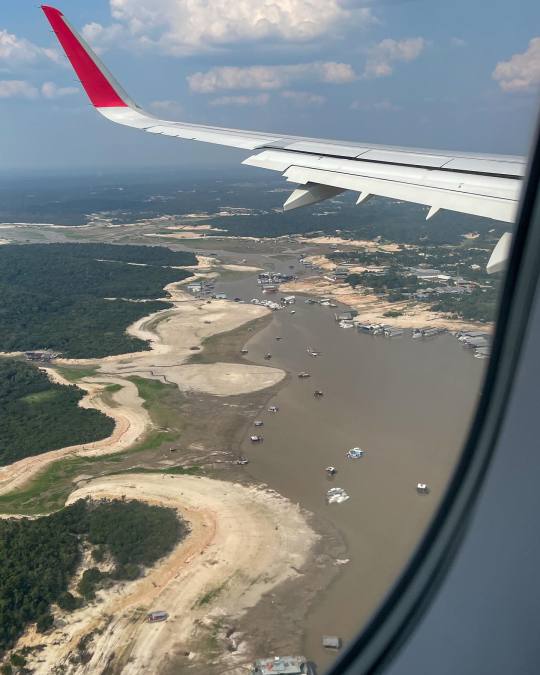

pictures by Adriano Liziero (ig: geopanoramas)
we are used to seeing images of rio negro and solimões, the two main amazon river affluents, in all their grandiose and beauty and seeing these pictures is really fucking chilling. some of our news outlets are saying the solimões has turned to a sand desert... can you imagine this watery sight turning into a desert in the span of a year?

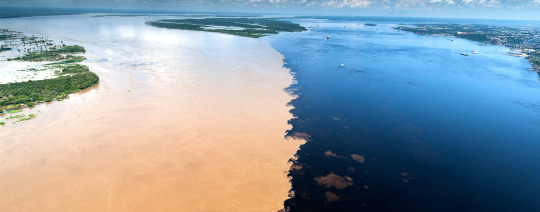
while down south we are seeing amounts of rain and hailstorms the likes of which our infrastructure is simply not built to deal with, up north people who have built everything around the river are at a loss of what to do.
the houses there that are built to float are just on the ground, people who depend on fishing for a living have to walk kilometers to find any fish that are still alive at all, the biodiversity there is at risk, and on an economic level it's hard to grasp how people from the northern states are getting by at all - the main means of transport for ANYTHING in that region is via the river water. this will impact the region for months to come. it doesnt make a lot of sense to build a lot of roads bc it's just better to use the waterway system, everything is built around or floats on the river after all. and like, the water level is so incomprehensibly low the boats are just STUCK. people are having a hard time getting from one place to another - keep in mind the widest parts of the river are over 10 km apart!!
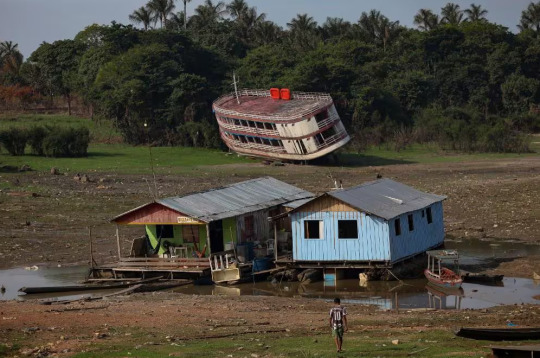
this shit is really serious and i am trying not to think about it because we have a different kind of problem to worry about down south but it's really terrifying when I stop to think about it. you already know the climate crisis is real and the effects are beyond preventable now (we're past global warming, get used to calling it "global boiling"). we'll be switching strategies to damage control from now on and like, this is what it's come to.
I don't like to be alarmist but it's hard not to be alarmed. I'm sorry that I can't end this post with very clear intructions on how people overseas can help, there really isn't much to do except hope the water level rises soon, maybe pray if you believe in something. in that regard we just have to keep pressing for change at a global level; local conditions only would not, COULD NOT be causing this - the amazon river is a CONTINENTAL body of water, it spans across multiple countries. so my advice is spread the word, let your representatives know that you're worried and you want change towards sustainability, degrowth and reduced carbon emissions, support your local NGOs, maybe join a cause, I don't know? I recommend reading on ecological and feminist economics though
however, I know you can help the affected riverine families by donating to organizations dedicated to helping the region. keep in mind a single US dollar, pound or euro is worth over 5x more in our currency so anything you donate at all will certainly help those affected.
FAS - Sustainable Amazon Fundation
Idesam - Sustainable Developent and Preservation Institute of Amazonas
Greenpeace Brasil - I know Greenpeace isn't the best but they're one of the few options I can think of that have a bridge to the international world and they are helping directly
There are a lot of other smaller/local NGOs but I'm not sure how you could donate to them from overseas, I'll leave some of them here anyway:
Projeto Gari
Caritás Brasileira
If you know any other organizations please link them, I'll be sure to reblog though my reach isn't a lot
thank you so much for reading this to the end, don't feel obligated to share but please do if you can! even if you just read up to here it means a lot to me that someone out there knows
also as an afterthought, I wanted to expand on why I think this hasn't made big news yet: because unlike the case of the 2020 forest fires, other countries have to hold themselves accountable when looking at this situation. while in 2020 it was easier to pretend the fires were all our fault and people were talking about taking the amazon away from us like they wouldn't do much worse. global superpowers have no more forests to speak of so I guess they've been eyeing what latin america still has. so like this bit of the post is just to say if you're thinking of saying anything of the sort, maybe think of what your own country has done to contribute to this instead of blaming brazil exclusively and saying the amazon should be protected by force or whatever
#solarpunk#sustainability#environmentalism#climate change#climate crisis#global warming#amazon rainforest#amazon river#geography#brazil#degrowth#punk#global boiling#ecopunk#anti capitalism#climate action#climate activism#the world does not die on my watch#i saw someone use that tag and uh i like it we should make it a thing#long post#:/ sorry i know no one likes lengthy bad news posts on their dashes but i've been thinking about this quite a bit#and i don't really know what to do to help bc i don't have money to donate and i am 10 thousand km away#i think i could be doing more to help but i am already trying my best#again dont feel obligated to share or read this but it would be nice and i would love you forever#have removed lbv from the post
7K notes
·
View notes
Photo

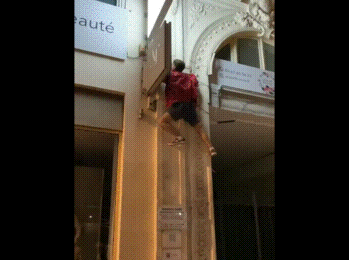
2022 - A group of activists use parkour to turn off useless energy wasting shop signs in Montpellier, France. [video]
#france#parkour#environmentalism#gif#2022#energy#anti-consumerism#solarpunk#direct action#anti-capitalism#capitalist hell#ads#advertisement#tactics#montpellier
67K notes
·
View notes
Text
So I've talked about little libraries and pantries to death but this Lil guy popped up in my area recently and it's blown my mind
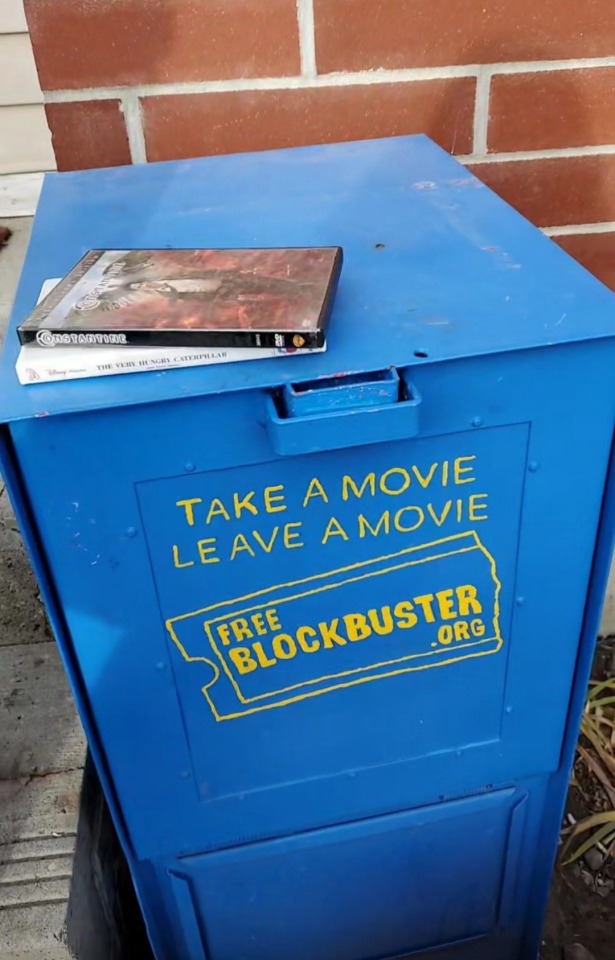

So I went to the website on the door and it's basically the same thing as free little library where you can pay for a box from them to get it installed OR Build one yourself


#direct action#mutual aid#free little#media#solarpunk#hopepunk#also gunna go on a seperate rant about my community after this but this is one cool thing
2K notes
·
View notes
Text
Hey y'all, there's a great Instagram acct called gogreensavegreen that just released three awesome resources for getting involved in collective action!

I'll include the link, they're going to be updating them and helping them grow, and they're AWESOME. Collective action is huge! Individual action is great for getting motivated, connecting with the earth, understanding resources, and growing passion, but these resources will take you further. I love just scrolling through them.
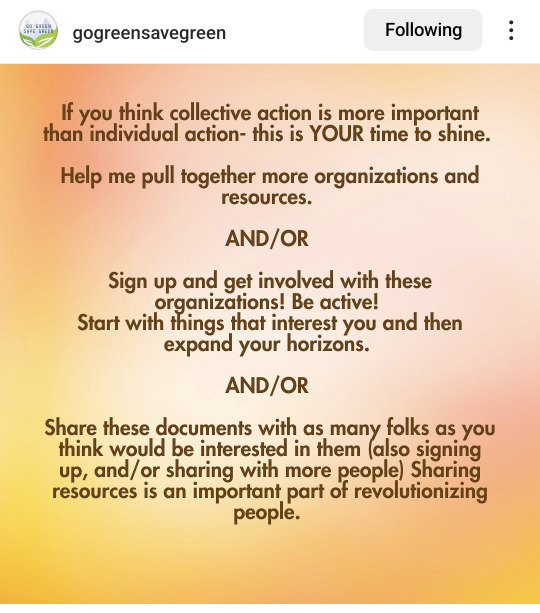
If you care about this and don't really know where to start THIS is for you. If you feel hopeless about our situation THIS is for you. If you find it hard to find like minded people THIS is for you!
Please boost and spread the word about this. We need as many people taking action as possible, and maybe this will help someone out there find their niche, their calling, their hobby, their action!
2K notes
·
View notes
Text
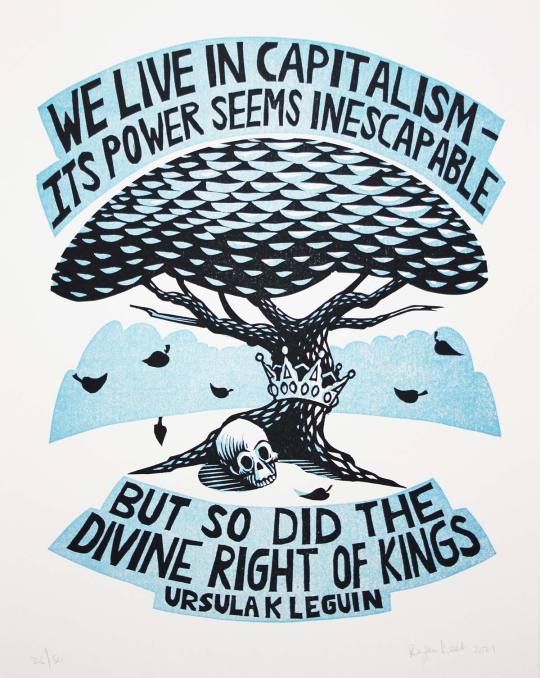
Artist credit:
#ursula k. le guin#hopepunk#hope punk#solar punk#solarpunk#futurism#climate and environment#climate action#climate hope#climate chaos#clean energy#capitalist society#capitalism#capitalist dystopia#resistance#faith in the future#economic justice#workers rights#imagine better
2K notes
·
View notes
Text
LunarPunk 🌙
Lunarpunk is Solarpunk for the night dwellers. Similar philosophy and movement but with a darker, bioluminescent, celestial aesthetic. With a focus on Community, Sustainability, Reducing Light Pollution, growing Native Flora and creating a livable and thriving home for the night dwelling Fauna (nocturnal animals, insects, and people too), and obviously, don't forget the Punk.
Lunarpunk is a very new and slowly growing subgenre and community, please continue to add new ideas, add to the conversation of sustainability, do research in your own area about the local flora and fauna, what you can do to help reduce light pollution, even if it's just coming from your home, how to be more energy efficient, how to reduce waste, save money on electricity, see if you can switch your lights to LEDs, speak with your neighbors about switching as well.
Any little bit counts.
#lunarpunk#sustainability#light pollution#environmentalism#ecopunk#solarpunk#recycling#climate change#climate action#night#environmental#envrionmental activists#punk#moon#lunar#flora and fauna#energy efficiency#ecofriendly#sustainable living#reduce reuse recycle
528 notes
·
View notes
Text
So a while ago I commissioned @thefruitloop-chan to make a Solarpunk poster for anyone to use! And this beautiful piece was made!
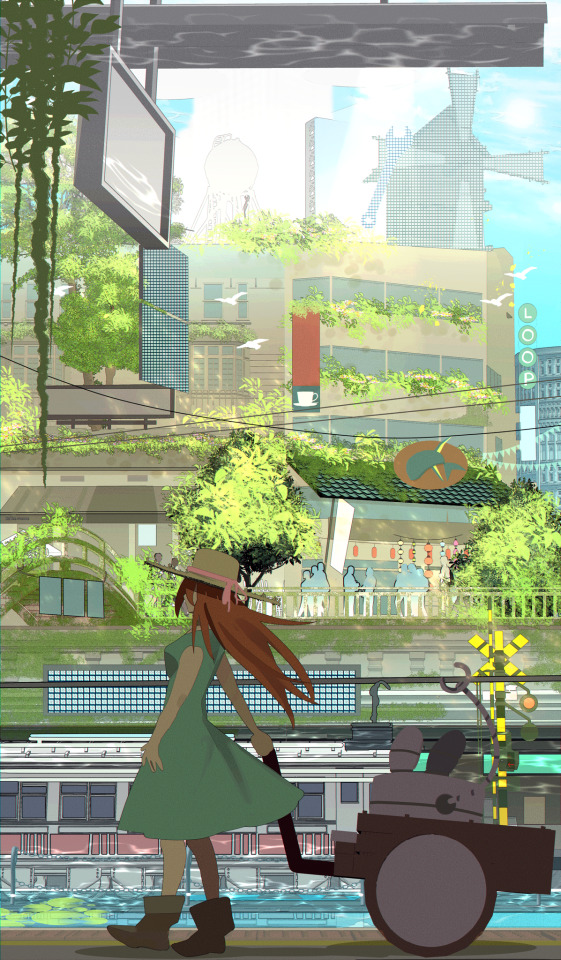
This is a blank for people to put text on, and here’s the two text ones that I put over


Anyone can print them and put them up and around town! Especially since it’s Solarpunk Action Week! Thank you again Squid for making this beautiful artwork! Let’s make a better future together!
#solarpunk#solarpunk art#solarpunk action week#poster#I plan on printing these bad boys tomorrow or so and putting around my local area#also if someone else puts text up on the blank one share it pls I wanna see what y’all come up with!
280 notes
·
View notes
Text
"Oh no, someone's attracted to the aesthetics of my -punk movement but doesn't know the praxis and history behind it like I do--"
OK. Tell them. Make it a teaching moment. Everyone who's in your movement learned the background from somewhere at some point, maybe this is that point for that person. Give them a jumping off point that they can dive into later.
"Oh but I shouldn't be responsible for teaching baby -punks about the history and the how-tos and--"
OK. Then don't tell them. You don't have to be responsible for teaching people with a budding interest in your group the ins and outs and how-tos. That's fair and valid! It can be a lot of work. Someone else will handle it
"But I'm annoyed that they would try to claim to be part of/be interested in my community without knowing all the details that I know after being in it for months/years/decades, they're dumb, they're posers, they're--"
OK. Then don't engage with them, if it's that bad. Maybe someone else will come around and tell them the history, maybe they'll pick it up on their own, maybe they'll just enjoy the fashion elements for awhile.
"But they shouldn't claim to be part of the -punk community if they don't know the--"
I feel like we have a few options here. People can either talk to them, share the history, share the values, share the praxis. Or they can just chase off anyone who even thinks about dipping a toe in their community, and then wonder why it's dying off later down the line.
I dunno, maybe I'm too naive and patient or whatever. But if people are entering your -punk spaces without knowing The Rundown of what you feel they need to know, maybe being nice about it and informing people instead of immediately assuming stupidity and malicious intent could help you make a new friend. Even the loudest voices in a space had to learn from somewhere, and not everyone has the luxury of being in the space as the History was Happening--whether it's an age thing or a not being aware of the space thing. Or maybe I just don't see what the big deal is behind people hating people who like the aesthetic of something and don't know the behind the scenes history about it yet.
Because I believe in the word 'yet.' No one comes into this world knowing everything about everything, and we're all constantly learning new things. I'm not gonna degrade someone and call them a poser for not knowing what I know. Because if it were me, interested in a scene but getting chased out and called a poser? I wouldn't hit the books and study up, I'd go 'that fuckin sucks, those people sucked' and then avoid anyone and anything having to do with it.
So chase people off and call them posers if you want. But if your community starts dwindling, don't be fucking shocked.
#out of queue#ani rambles#punks and posers#i cant even call this a 4am hot take because its 7pm but like#idk i keep seeing posts about like 'how DARE people think I bought my punk clothes how DARE they not know the how-tos and DIYs'#or 'ugh people only care about the ~aesthetics~ of my movement if you don't know shit get out of here' and like#maybe I'm just a shy ass introverted nerd whos scared of social rejection! but I avoid that shit like the plague#so if someone were to reject me based on not knowing about something I'd never even heard about? something i was JUST getting into?#there's a high chance I'd just scram and never look back. i don't wanna be the one who causes that emotion in someone else#granted this is coming from someone who STILL doesn't know how to make her own patches or worked up the courage to do direct action praxis#outside of offering neighbors to my tomatoes and trying to talk to people about what I'm passionate about#but still imo unless someone's a malicious intentional bad actor i dont see the point in scaring newbies off#thats how movements die imo#i know this is my solarpunk blog but its not a solarpunk specific thing#i think the main post that inspired this was about store-bought versus self-made spiked leather jackets#which honestly just feels petty to me but who knows.#might delete later
2K notes
·
View notes
Text

Made this for the Solarpunk Aesthetic Week server in a sudden creative fever, so I guess I'll post it here too hh
A relative of mine knows someone who teaches kids, so I'm gonna suggest this as an art project for them! The idea is that students could each make/decorate their own shelf, then put them together to form a hive, which could function as mini lockers in their classrooms. Then, by the end of the school year or something, they could either take their own little shelf home (or exchange them with their peers?), or recycle them into materials for the next class! Hopefully it'll teach them about pollinators too 🐝
Idk how doable this project is really, and its scary to imagine one of my silly designs could actually become something tangible irl. But even so, I'm still excited to try 🥰 (And if anyone else attempts this too, please let me know!!!)
#art#artists on tumblr#solarpunk#earth day#ani if u see this thank u for the inspiration <3#and uhhh idk if art can be considered action but.......#solarpunk action week#SPAW#roobiedoodle#not many people responded in the server so idk if its any good really ;;;; just leaving it here to archive ig#so far ive only shared solarpunky ideas within my tiny social circle so. its scary to think about reaching out to strangers with all this#ik like community is a big part of the movement but liiiike. OOOGH. WAAAGH IDK IDK WE'LL SEE HOW IT GOES#ok. random extra idea: i think the nest design would also look vv cool as a ceiling lamp 💡 thats how it hangs irl anyway!#bugs#wasp#insects#<-SORRY I FORGOT TO TAG WARNINGS
213 notes
·
View notes
Text
I saw a post talking about how we shouldn't celebrate when organizations, people, countries and etc make changes to be more accepting towards minorities or make changes that would better the world because "they should have already done that."
The ideal world we want, where everyone can live a kind and nice life, isn't going to happen in one massive swoop. It is going to come in tiny steps over many, many years. And guess what? We should celebrate each step we take. Each time something changes for the better we are closer to what we've all been dreaming of and that is something worth celebrating. If we refuse to find happiness in small victories, we won't have the strength to make it to the end.
So throw a party with some of your friends when your city council installs bike lanes. Go protest outside the shop down the street for being bigoted. Kick Karen out of the neighborhood group chat and go out for dinner with the rest. It's worth it not just in the end but to you in the present. You should, and need, to celebrate small achievements.
#solarpunk#direct action#protest#riot#movement#anarchy#anarchist#leftism#communism#anarchocom#ancom#socialism#leftist#anarchocommunism
634 notes
·
View notes
Text
"With “green corridors” that mimic the natural forest, the Colombian city is driving down temperatures — and could become five degrees cooler over the next few decades.
In the face of a rapidly heating planet, the City of Eternal Spring — nicknamed so thanks to its year-round temperate climate — has found a way to keep its cool.
Previously, Medellín had undergone years of rapid urban expansion, which led to a severe urban heat island effect — raising temperatures in the city to significantly higher than in the surrounding suburban and rural areas. Roads and other concrete infrastructure absorb and maintain the sun’s heat for much longer than green infrastructure.
“Medellín grew at the expense of green spaces and vegetation,” says Pilar Vargas, a forest engineer working for City Hall. “We built and built and built. There wasn’t a lot of thought about the impact on the climate. It became obvious that had to change.”
Efforts began in 2016 under Medellín’s then mayor, Federico Gutiérrez (who, after completing one term in 2019, was re-elected at the end of 2023). The city launched a new approach to its urban development — one that focused on people and plants.
The $16.3 million initiative led to the creation of 30 Green Corridors along the city’s roads and waterways, improving or producing more than 70 hectares of green space, which includes 20 kilometers of shaded routes with cycle lanes and pedestrian paths.
These plant and tree-filled spaces — which connect all sorts of green areas such as the curb strips, squares, parks, vertical gardens, sidewalks, and even some of the seven hills that surround the city — produce fresh, cooling air in the face of urban heat. The corridors are also designed to mimic a natural forest with levels of low, medium and high plants, including native and tropical plants, bamboo grasses and palm trees.
Heat-trapping infrastructure like metro stations and bridges has also been greened as part of the project and government buildings have been adorned with green roofs and vertical gardens to beat the heat. The first of those was installed at Medellín’s City Hall, where nearly 100,000 plants and 12 species span the 1,810 square meter surface.
“It’s like urban acupuncture,” says Paula Zapata, advisor for Medellín at C40 Cities, a global network of about 100 of the world’s leading mayors. “The city is making these small interventions that together act to make a big impact.”
At the launch of the project, 120,000 individual plants and 12,500 trees were added to roads and parks across the city. By 2021, the figure had reached 2.5 million plants and 880,000 trees. Each has been carefully chosen to maximize their impact.
“The technical team thought a lot about the species used. They selected endemic ones that have a functional use,” explains Zapata.
The 72 species of plants and trees selected provide food for wildlife, help biodiversity to spread and fight air pollution. A study, for example, identified Mangifera indica as the best among six plant species found in Medellín at absorbing PM2.5 pollution — particulate matter that can cause asthma, bronchitis and heart disease — and surviving in polluted areas due to its “biochemical and biological mechanisms.”
And the urban planting continues to this day.
The groundwork is carried out by 150 citizen-gardeners like Pineda, who come from disadvantaged and minority backgrounds, with the support of 15 specialized forest engineers. Pineda is now the leader of a team of seven other gardeners who attend to corridors all across the city, shifting depending on the current priorities...
“I’m completely in favor of the corridors,” says [Victoria Perez, another citizen-gardener], who grew up in a poor suburb in the city of 2.5 million people. “It really improves the quality of life here.”
Wilmar Jesus, a 48-year-old Afro-Colombian farmer on his first day of the job, is pleased about the project’s possibilities for his own future. “I want to learn more and become better,” he says. “This gives me the opportunity to advance myself.”
The project’s wider impacts are like a breath of fresh air. Medellín’s temperatures fell by 2°C in the first three years of the program, and officials expect a further decrease of 4 to 5C over the next few decades, even taking into account climate change. In turn, City Hall says this will minimize the need for energy-intensive air conditioning...
In addition, the project has had a significant impact on air pollution. Between 2016 and 2019, the level of PM2.5 fell significantly, and in turn the city’s morbidity rate from acute respiratory infections decreased from 159.8 to 95.3 per 1,000 people [Note: That means the city's rate of people getting sick with lung/throat/respiratory infections.]
There’s also been a 34.6 percent rise in cycling in the city, likely due to the new bike paths built for the project, and biodiversity studies show that wildlife is coming back — one sample of five Green Corridors identified 30 different species of butterfly.
Other cities are already taking note. Bogotá and Barranquilla have adopted similar plans, among other Colombian cities, and last year São Paulo, Brazil, the largest city in South America, began expanding its corridors after launching them in 2022.
“For sure, Green Corridors could work in many other places,” says Zapata."
-via Reasons to Be Cheerful, March 4, 2024
#colombia#brazil#urban#urban landscape#urban planning#cities#civil engineering#green architecture#green spaces#urban heat#urban heat island effect#weather#meteorology#global warming#climate change#climate hope#climate optimism#climate emergency#climate action#environment#environmental news#city architecture#bicycling#native plants#biodiversity#good news#hope#solarpunk#ecopunk#hopepunk
13K notes
·
View notes
Text
Currently in progress: building garden beds for free! (Aside from the cost of an axe & hatchet) I really had my heart set on raised garden beds but ultimately it would be too expensive to get the supplies right now, and we need to thin out the trees in our backyard. (Lots of skinny trees in high density) the previous owners left all those plant pots and grow bags in the picture, my son likes to play with them for now. :) (soon they will house my peppers!)
The sun stays on the left side of the yard, and luckily that’s where the highest density trees are, so once we cut them down it’ll open up the canopy and let in more light. I’ll have to get some topsoil though, the soil here is compacted as fuck!! (Seriously, I’ve never seen soil so compacted) where it looks like a bush behind the beds ( it’s trees we cut down) there’s a natural dip in the ground about 1-2 ft and I’m planning to put a wildlife pond there using a no-liner method.
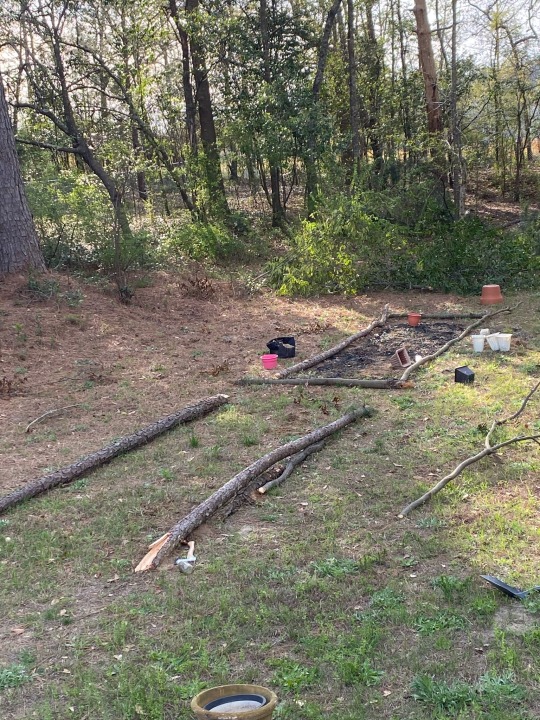
Most of the light green growing in this picture is Chinese privet I haven’t yet cut down :/ and now I can see alllllll the poison oak that’s popping up :))))))) (I’m very allergic)
…
Front yard!
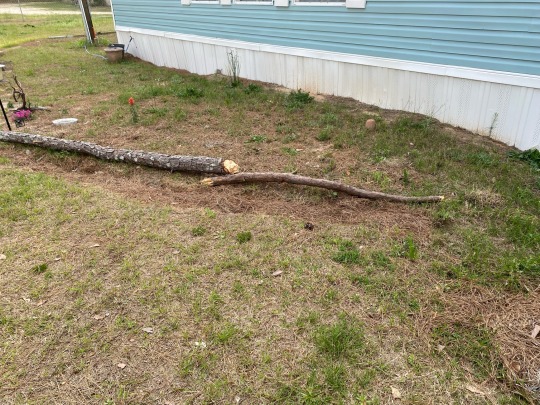
I got a packet of wildflower seeds and they’re just starting to pop up so I took a picture to compare to when they are more/fully grown! I also got some moss phlox (native) and snapdragons (favorite flower).
197 notes
·
View notes
Text
Notes Toward Finding Community, Or, How to Find Community When You Feel Isolated
Neoliberalism sucks for a ton of reasons. From the enclosure of every common, to the commodification of every creation, it feels like a muzzle on humanity that gets tighter and tighter. One of the most underexplored aspects of neoliberalism is the way in which it creates and reinforces isolation. People don’t really have communities outside of consumption or compulsion. This is problematic for a ton of reasons, namely that it prevents us from fulfilling our basic needs. Humans are social creatures. People need to have connections with folks. People may not all need the same levels or intensity of connections, but connections are important nonetheless. To lack in the ability to socialize meaningfully is to ensure worse health outcomes, mentally, emotionally, and physically. But, I don’t mean to freak you out. I think that there are steps we can take to star building community, bridging gaps with the people around us.
Think About What You Want
When folks feel very isolated, it can be easy to accept anything. If we’re in a vulnerable state, that could leave us open for ending up in precarious situations. One way to fight against this is to start from the position of imagining what community looks like. Is the type of space we want to occupy based around interests (fandom, hobbies)? Religions, spiritualities, social issues? If we are able to list the things that excite us, we have a good idea of what to look for, and can focus our efforts towards finding those spaces.
Find the Watering Holes
With the spaces we’re interested in on hand, youcan find where folks gather. Every community has virtual and/or in-person spaces. For example, if you’re a film fan, you can look for indie cinemas, folks putting on screenings, or look into film societies where you live. For activism, I’ve written a whole guide on how to get started. Looking for those spaces will allow you to start getting integrated in the space. Really think about how you can occupy the same physical and digital spaces of people who are into what you’re into.
Go Meet Folks
Now, this may be difficult, depending on your disposition. The quickest way to meet folks is to put yourself out there. It’s always vulnerable to put yourself on the line in this way, but it’s super necessary. When you’re in spaces with similar folks, you have talking points built in! You don’t have to worry if the folks around you will like movies at film club. If you are enjoyable to be around, through being nice, interesting, and/or being an active listener, you’ll be making connections in no time. If you’re not willing to talk to folks, it’ll be hard to make connections. Being open is an asset towards the end of getting connected. At the very least, consistently go to events and spaces in your interest area(s). Maybe you’ll bump into an extroverted person that can show you the ropes.
Be the Change You Want to See
As you get out there, think about how you can start catalyzing community. Maybe you host a dinner for neighbors. Maybe you start a book club. Or even a neighborhood garden, or cleanup event. In this way, you’re flipping the issue on its head. You’re creating the space to meet folks yourself. It’s like being a magnet, drawing others to you.
We need community. It’s a necessary thing, you know? So, hopefully, keeping these things in mind helps in that regard.
#economics#economy#econ#anti capitalists be like#neoliberal capitalism#late stage capitalism#anti capitalism#capitalism#activism#activist#direct action#solarpunks#solarpunk#praxis#socialism#sociology#social revolution#social justice#social relations#social ecology#organizing#complexity#resist#fight back#organizing 101#radicalization#radicalism#prefigurative politics#politics
542 notes
·
View notes
Text
Unexpected by almost all, here is good climate news from this week! According to calculations by the International Energy Agency, global CO2 emissions may stop rising and even begin falling as soon as this year - yes, this year, 2023. All trends point towards accelerated uptake of renewable electricity, electric vehicles, and while unmentioned in the article, there are technologies like zero-carbon steel and negative-carbon concrete waiting in the wings. And while the path to no more than 1,5C warming remains narrow, there is no runaway warming prospect at 1,5C above preindustrial; in fact, runaway warming without external events is likely impossible, because a warming Earth radiates more heat than it traps (another IPCC finding). In that light, limiting warming to 1,7C (the would-be result of current pledges by all countries) would be almost as effective, and a very good thing. Besides - who's to say that uptake of renewables won't accelerate even more, like they've already beaten every growth prediction in the last few years? So - definitely good news.
#global warming#climate change#climate action#solarpunk#bright green environmentalism#reasons for hope#hope#psa#debunking doomsday#you're doing everything right holmes just keep whacking moriarty over the head
273 notes
·
View notes